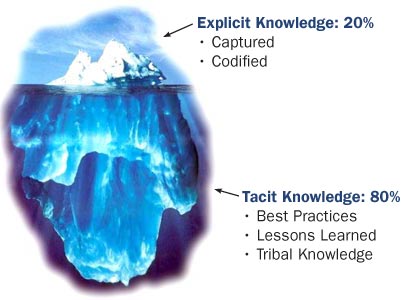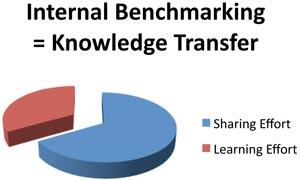ONLINE EXCLUSIVE: Knowledge Sharing
Bill Baker and Ron Webb
By benchmarking internally in your organization, you can learn what has already been learned and what works. You will not be “reinventing the wheel.” One of the hardest things for some people to do is share their knowledge. They see it as threatening their job, expertise, and net worth.
The counter to that perceived threat is that an expert can build self-worth by sharing and mentoring others, continuing to learn while validating expertise and best practices. This knowledge can be critical to the success of the organization. Since continuous improvement toward excellence is what today’s competition is all about, intellectual capital must be captured, shared, and leveraged within the organization.
Everyone says, “People are our most important asset.” What we really mean is that the tacit (non-written) knowledge of our people is our most important asset. An estimated 80 percent of our corporate knowledge is tacit, sometimes called tribal knowledge. If we look at our corporate knowledge as an iceberg it would look like Figure 1.

Figure 1. Corporate knowledge is like an iceberg where the majority of knowledge lies below the surface. All that tacit knowledge has been gained by trial and error and many cycles of learning by the individual as well as the company. Stockholders consider throwing it away as a serious blunder.
Support Sharing
How do we capture knowledge and leverage it so the company can continue to excel? The company culture must support and encourage sharing, recognizing, and rewarding both the “sharing party” and the “learning party.” (See Figure 2.) The rule of thumb is that two-thirds of the work of sharing must be done by the sharing party and one-third by the learning party.

Figure 2. Two-thirds of the work of sharing must be done by the sharing party and one-third by the learning party.
How do we support the effort and make it a cultural norm? Several ways used by successful companies come to mind:
- Include sharing and learning on individual performance reviews.
- Hold sharing/learning award ceremonies led by the chief executive.
- Honor subject matter experts who mentor junior employees.
- Initiate Communities of Practice (CoP) in core processes, providing a learning environment.
- Encourage middle management to promote sharing and learning at the work center location.
These cultural support elements make a few critical statements about building a sustainable sharing/learning culture:
- You are important.
- Sharing your knowledge is important.
- Learning from others is important.
- Management supports taking the time to share.
- We are a team working to advance our organization.
Internal benchmarking and sharing can be the fastest way to continuously improve. If it works in one division or location, it will probably work in a similar operation headed by similar management.
CoPs enable people with common interests to gather in a non-threatening atmosphere and talk about similar problems, past solutions, and future applications. Companies sometimes sponsor a CoP, providing lunch and a facilitator. The facilitator calls meetings, setting up “hot” topics and speakers to maintain interest.
CoPs have been described as fragile as an egg. Attendance and sharing are optional, and if attendees do not receive benefits, they will stop attending. The facilitator must be a knowledgeable, community-building individual. Great ideas and mentoring have emanated from CoPs!
Internal benchmarking is all about building internal networks of people willing to share and learn in a continuous improvement manner. After all, culture trumps strategy, so we have to change the culture!
Bill Baker is the Association for Manufacturing Excellence (AME) vice president for alliances. Ron Webb is the executive director of membership and research for APQC. This article is the final part in a four-part series of articles about benchmarking.


